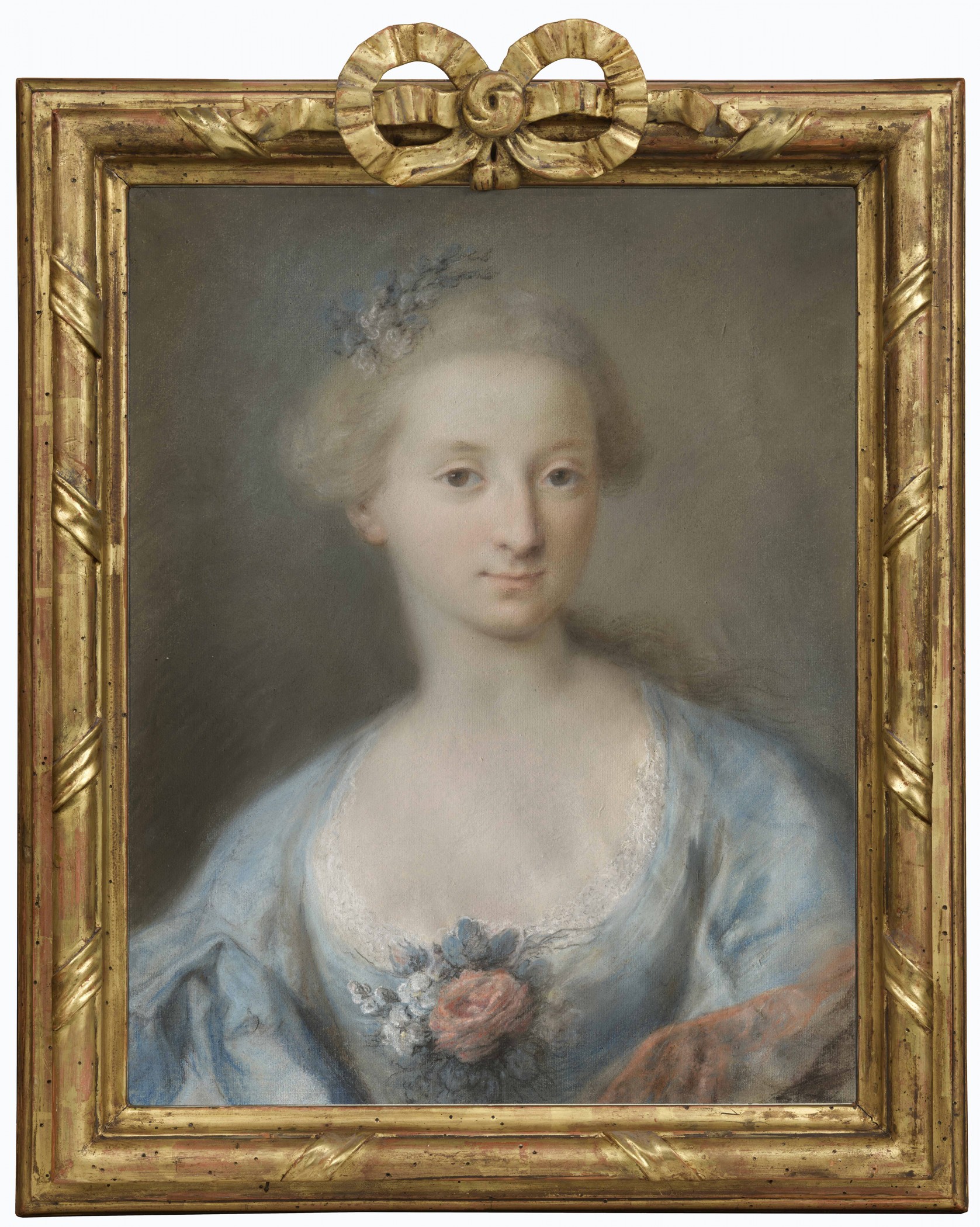Rosalba Carriera
(Venice 1673 - 1575 Venice)
Portrait of Countess Revedin (Allegory of Faith and Purity), c. 1740
pastel on blue paper, 51 x 40,5 cm (20.08 x 15.94 inches)
Rosalba Carriera
(Venice 1673 - 1575 Venice)
Portrait of Countess Revedin (Allegory of Faith and Purity), c. 1740
pastel on blue paper, 51 x 40,5 cm (20.08 x 15.94 inches)
Re: 858
Provenance: Revedin collection, Ferrara
P. Zampetti, Dal Ricci al Tiepolo. I Pittori di figura del Settecento a Venezia, exhibition catalogue, Venice, Palazzo Ducale, 7 June - 15 October 1969, pag. 170, n. 77
Witt Library, The Courtauld Institute, London
A young lady is depicted here slightly three-quarter view. She is dressed in a cerulean dress and on her left arm she wears an orange (complementary) mantle. The wide neckline is closed by a bundle of flowers, among which is a rose, a symbol of love, devotion and purity. This beautiful portrait, executed in pastel on paper, is the work of the famous Venetian painter Rosalba Carriera and comes ab antiquo from the collection of the Revedin family. This circumstance makes it very plausible that the portrait depicts a young woman from the dynasty, at a time when the dynasty was gaining prominence in Venetian society. The Revedins, a family of probable Genevan origin, appear in documents of the Serenissima from the late 17th century onwards[1].
The first name one comes across is that of Giovan Battista, who lived in a palazzo in the Dorsoduro sestiere near the Zattere in the early 18th century. His nephew Antonio, born in 1708, was the one who brought the family to noble dignity, acquiring - by decree of the senate on 1st March 1755 - the title of count for himself and his entire family. At that time, as the reasons given in the aforementioned decree indicate, the Revedins were among the most important exponents of Venice's merchant navy, and their economic fortune led them a few years later to move from the Zattere to the much more prestigious Campo San Paternian (today Campo Manin), a few steps from St. Mark's. It is likely that the merits of this growth in wealth were Antonio's own, and that the female portrait by Rosalba's hand that would later be conserved in the dynastic collections - a portrait to be dated around 1740 - was a sort of certification of the advancement of social status.
Rosalba Carriera had begun to devote herself to pastel portraits in her early maturity, when her name was already known for the delicate ivory miniatures executed in her formative years - miniatures that decorated snuff boxes or small jewel boxes. It was some famous pictures she conducted in pastel in the years 1708-1710, such as the Portrait of Pisana Mocenigo in the Gemäldegalerie Alte Meister in Dresden[2] or the Portrait of Frederick IV of Denmark now in the Nationalhistoriske Museum in Hillerød[3], that ensured Rosalba a success that quickly spread throughout Europe, from Spain to Russia. After a long stay in Paris between 1720 and 1721 - during which she was elected a member of the Académie Royale de peinture et de sculpture and was able to compare herself on an equal footing with the artists of the court of Versailles - and a trip to Vienna in 1730, once back home, the painter gradually abandoned the rocaille manner that had made her a success and embraced a new poetic style that was more intimate and personal in her portraits. Having passed the age of sixty, Rosalba is no longer interested in lingering over the emblematic elements of power and social distinction of the lords she depicts. In the last phase of her career - which ended prematurely in 1746 due to an eye disease that soon led to blindness - the artist seems to want to scrutinise the faces and grasp the secrets of her subjects.
At this stage, the subjects are for the most part unnamed, and even when we do know their identities, they are characters who are clearly intended to be described in their emotional and psychological component, often accompanied by iconographic elements evocative of their character. It is no coincidence that the portrait presented here, a work as mentioned to be related to the last years of the painter's activity, can be compared to some of the enchanting Allegories painted by Rosalba at the beginning of the fifth decade of the 18th century: suffice it to think of the Four Elements (Air, Water, Earth, Fire) executed for the apostolic nuncio Giovan francesco Stoppani and now in the Galleria Nazionale d'Arte Antica of Palazzo Corsini in Rome[4], or the similar series requested from Rosalba by Frederick Augustus of Saxony between 1744 and 1746 (now in the Gemäldegalerie in Dresden)[5]. The Countess of the House of Revedin thus becomes here a true allegory of youth and purity - symbolised, moreover, by the rose on her breast -: an image that still amazes today, as Pietro Zampetti[6] has rightly pointed out, for the psychological sensitivity and candour emanating from the face of this young woman.
[1] On the Revedins, who during the 19th century moved from Venice to Ferrara, going to live in the villa in Via Bolognese that still bears their name, see V. Spetri, Enciclopedia storico-nobiliare italiana, Milan 1928, VIII, pp. 522-524; see also L. Rocco, Motta di Livenza e i suoi dintorni, Treviso 1897, pp. 593-594
[2] B. Sani, Rosalba Carriera 1673-1757. Maestra del pastello nell'Europa ancien régime, Turin 2007, pp. 72-73, n. 22.
[4] A. Pasian, in Rosalba Carriera "prima pittrice d'Europa", edited by G. Pavanello, exhibition catalogue (Venice, Galleria di Palazzo Cini, 1 September - 28 October 2007), Venice 2007, pp. 144-149, nos. 32-35

